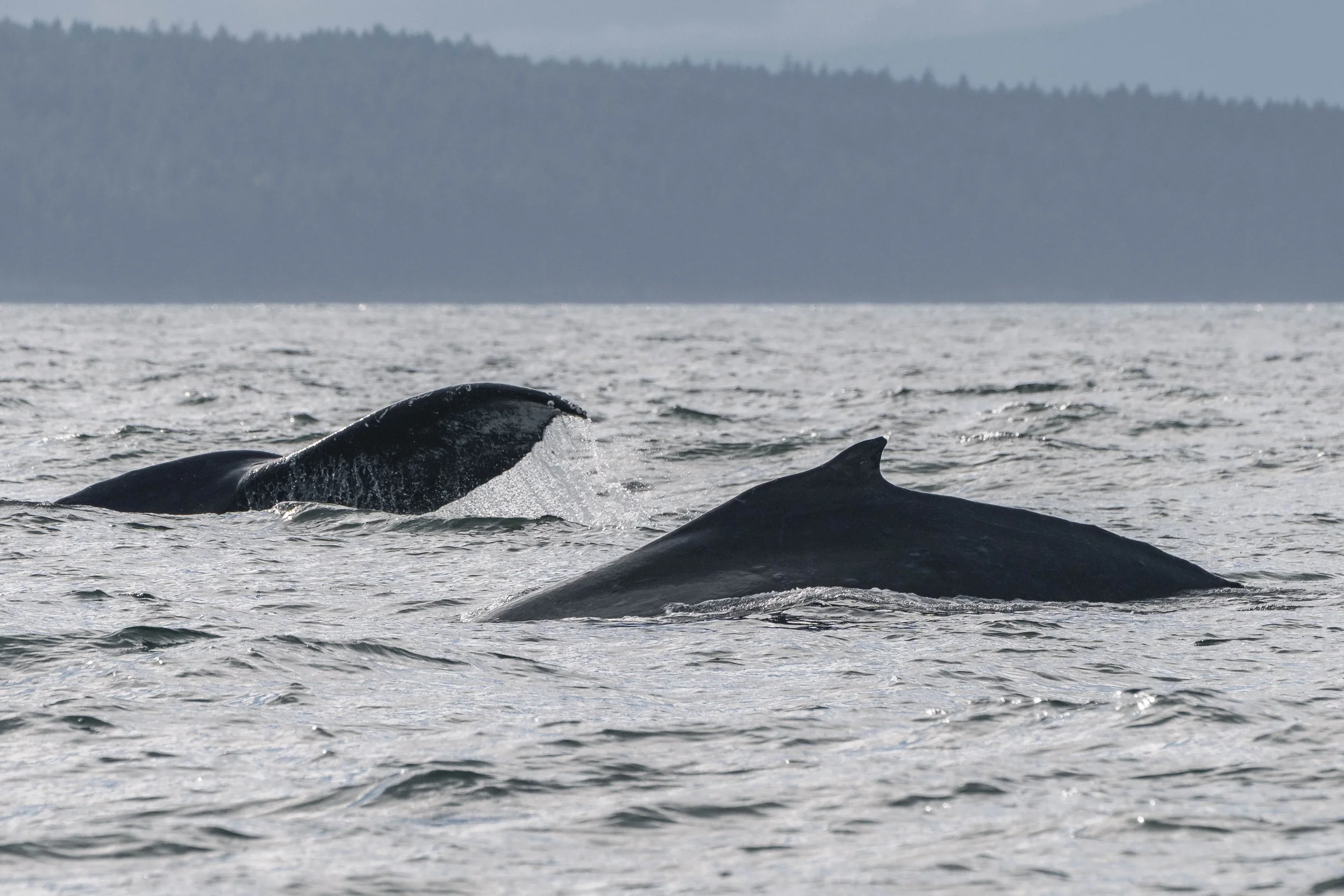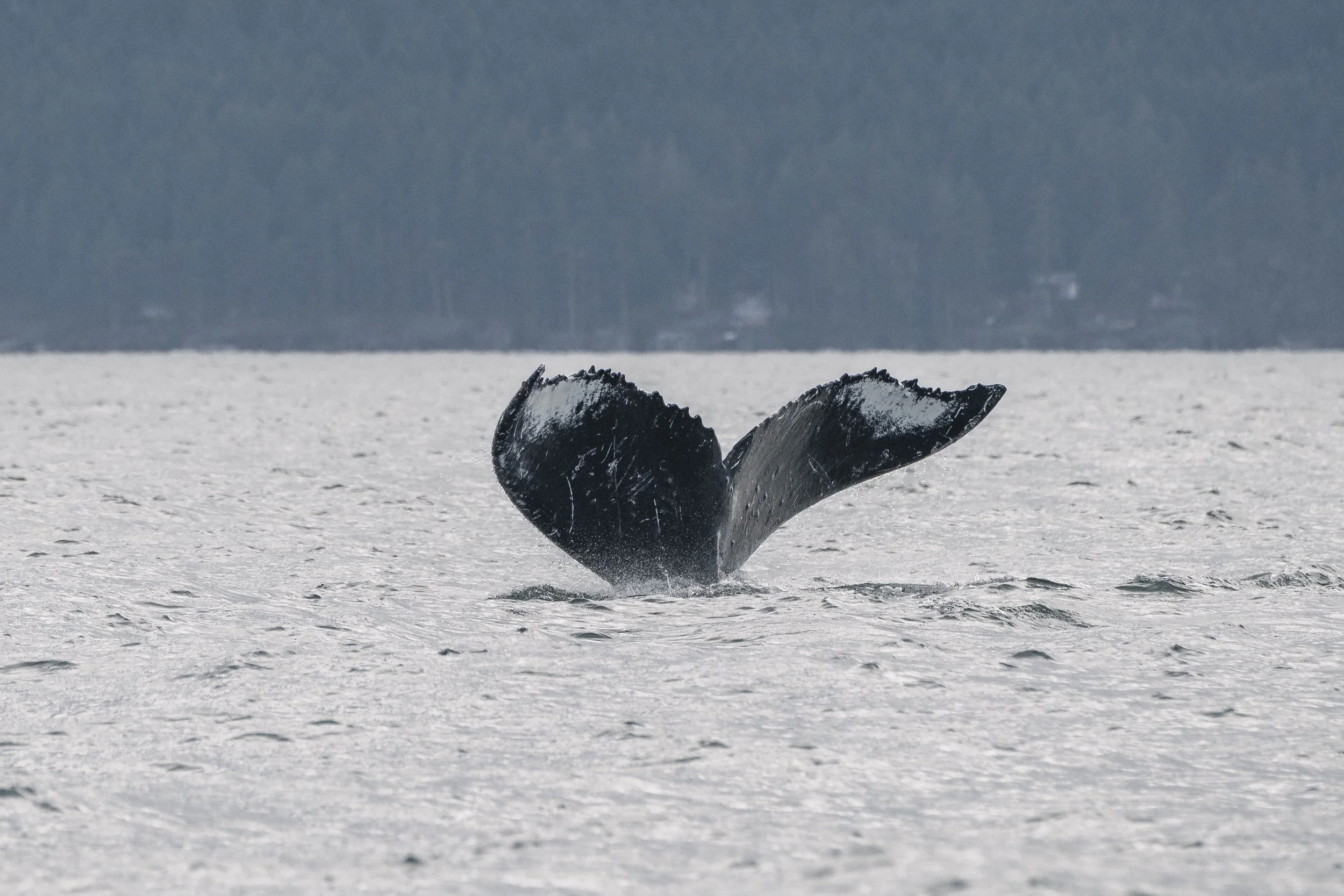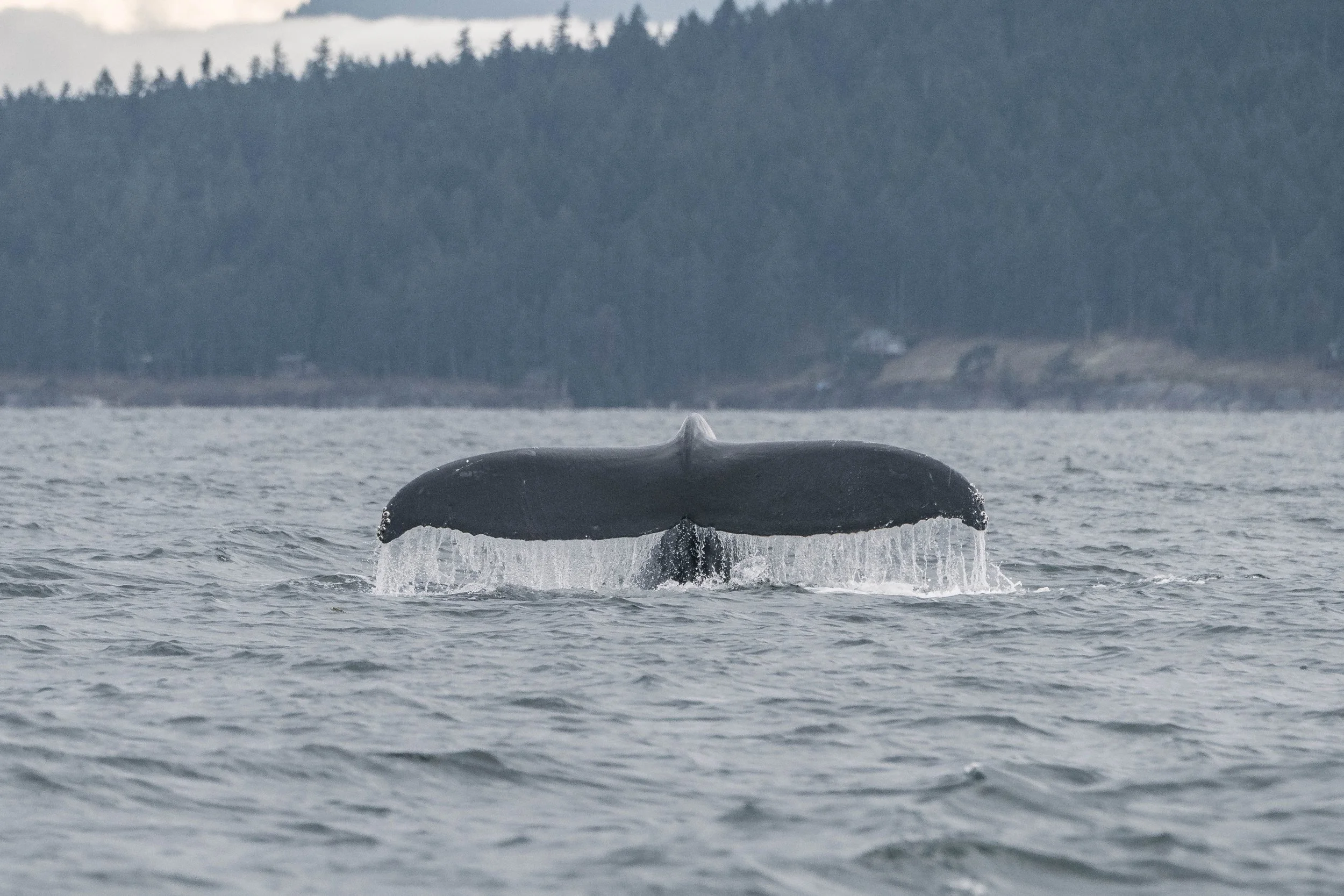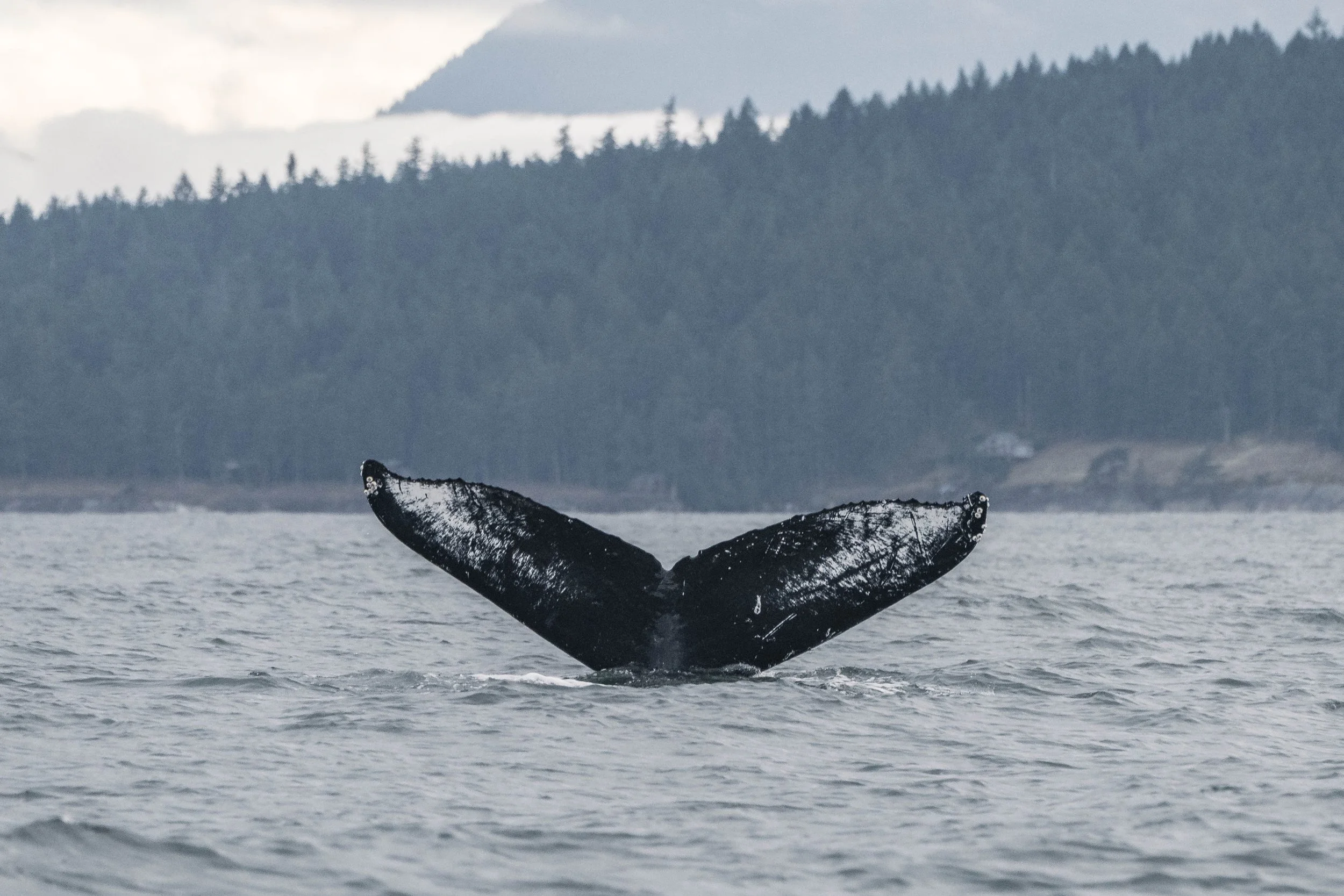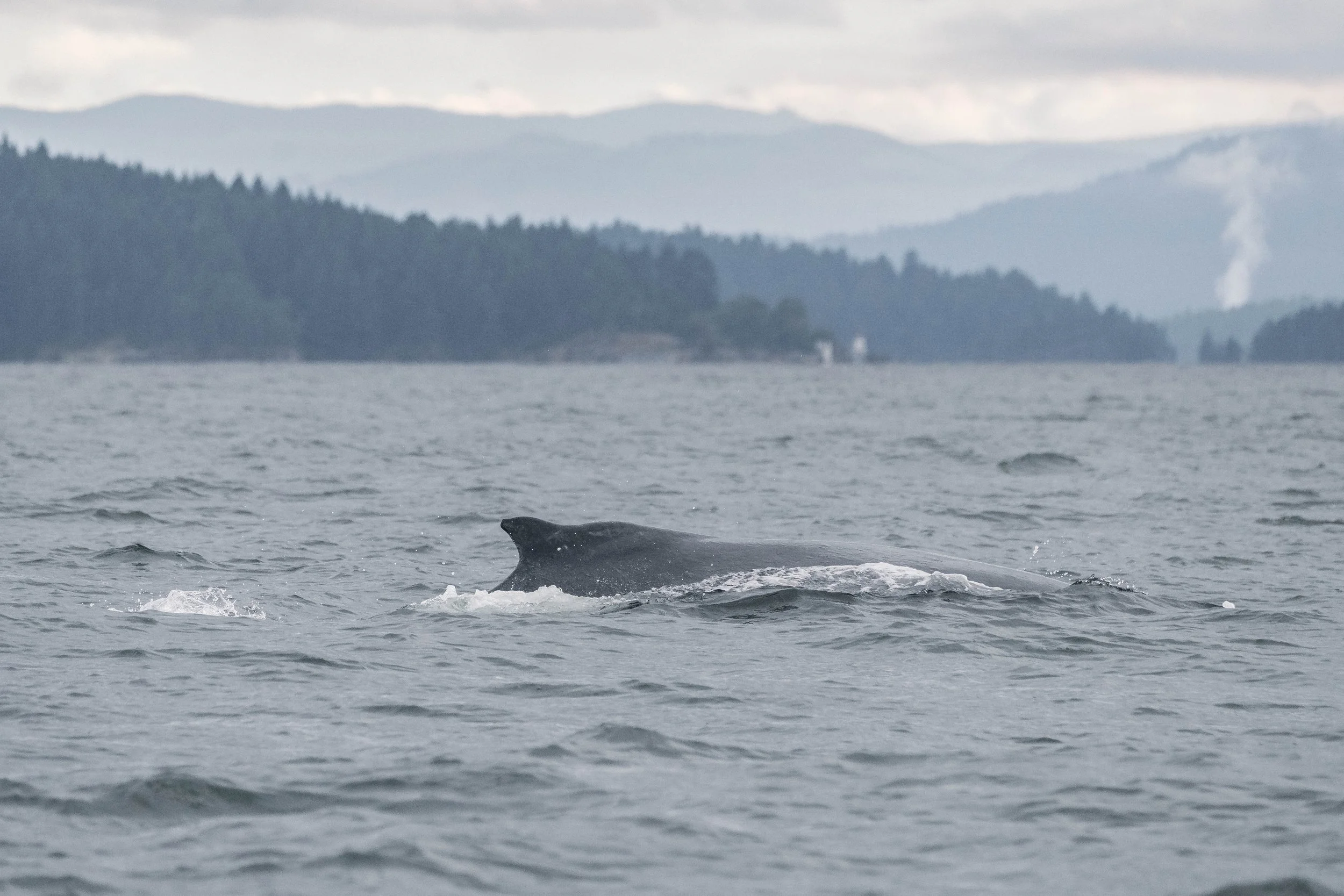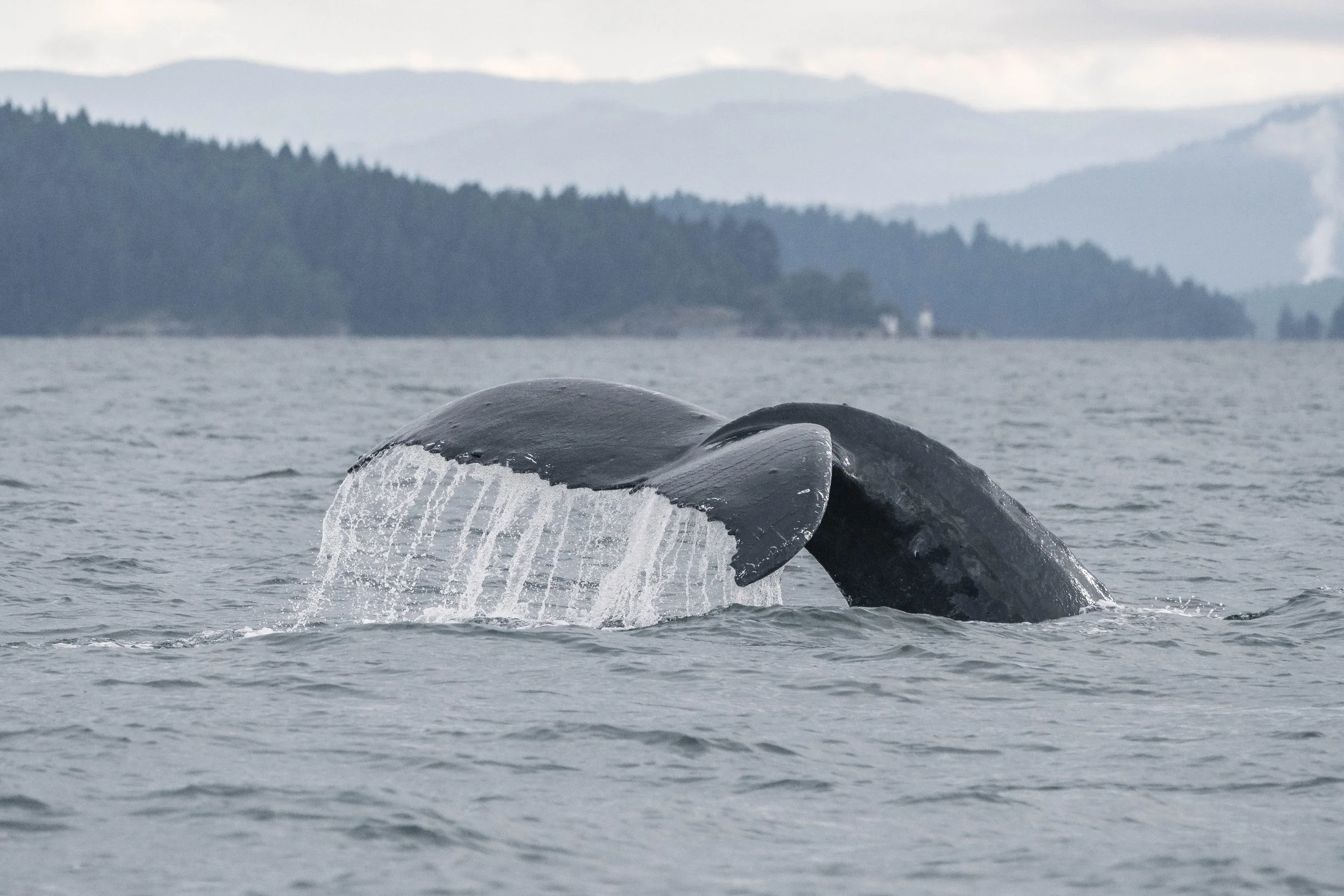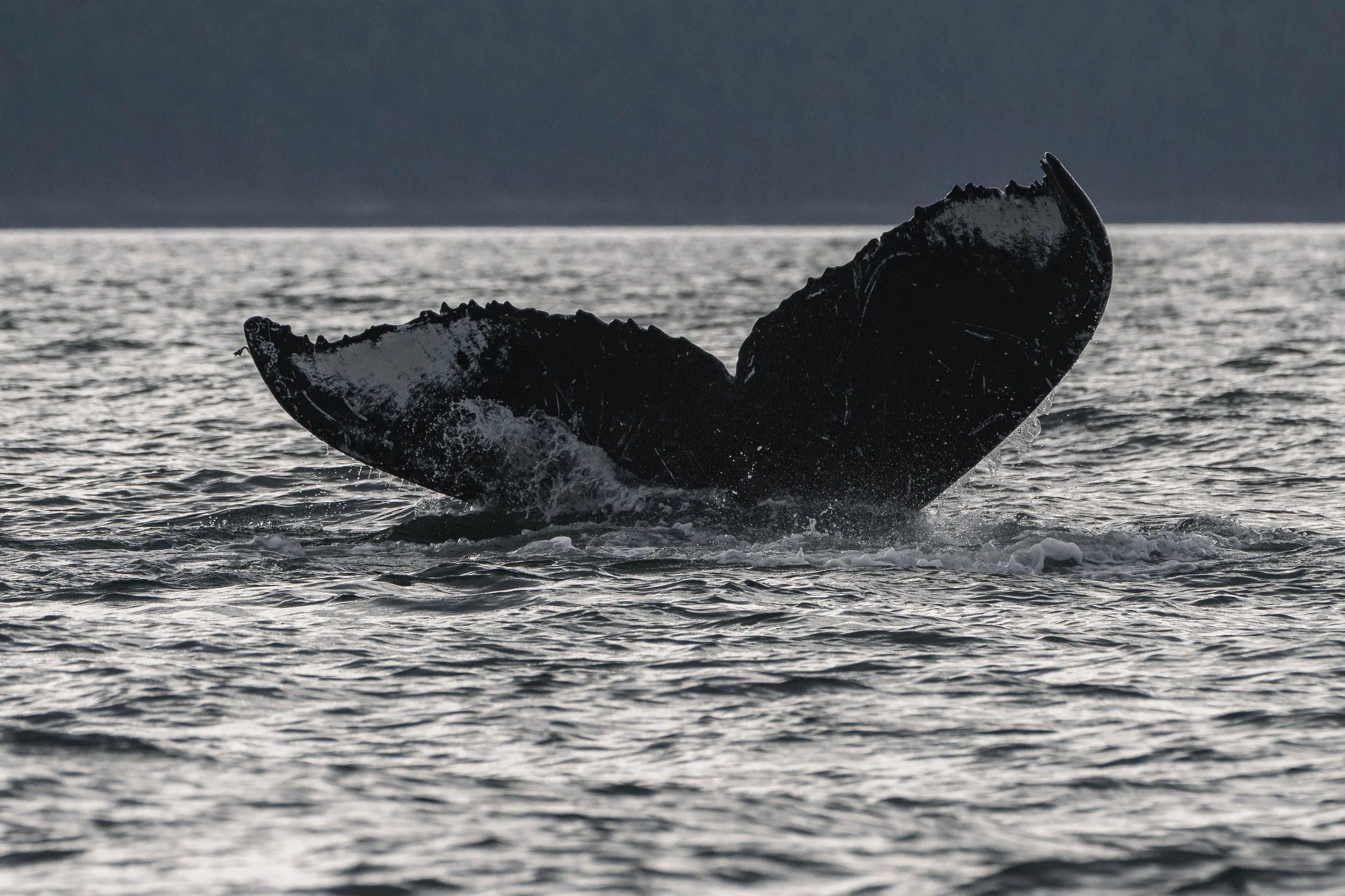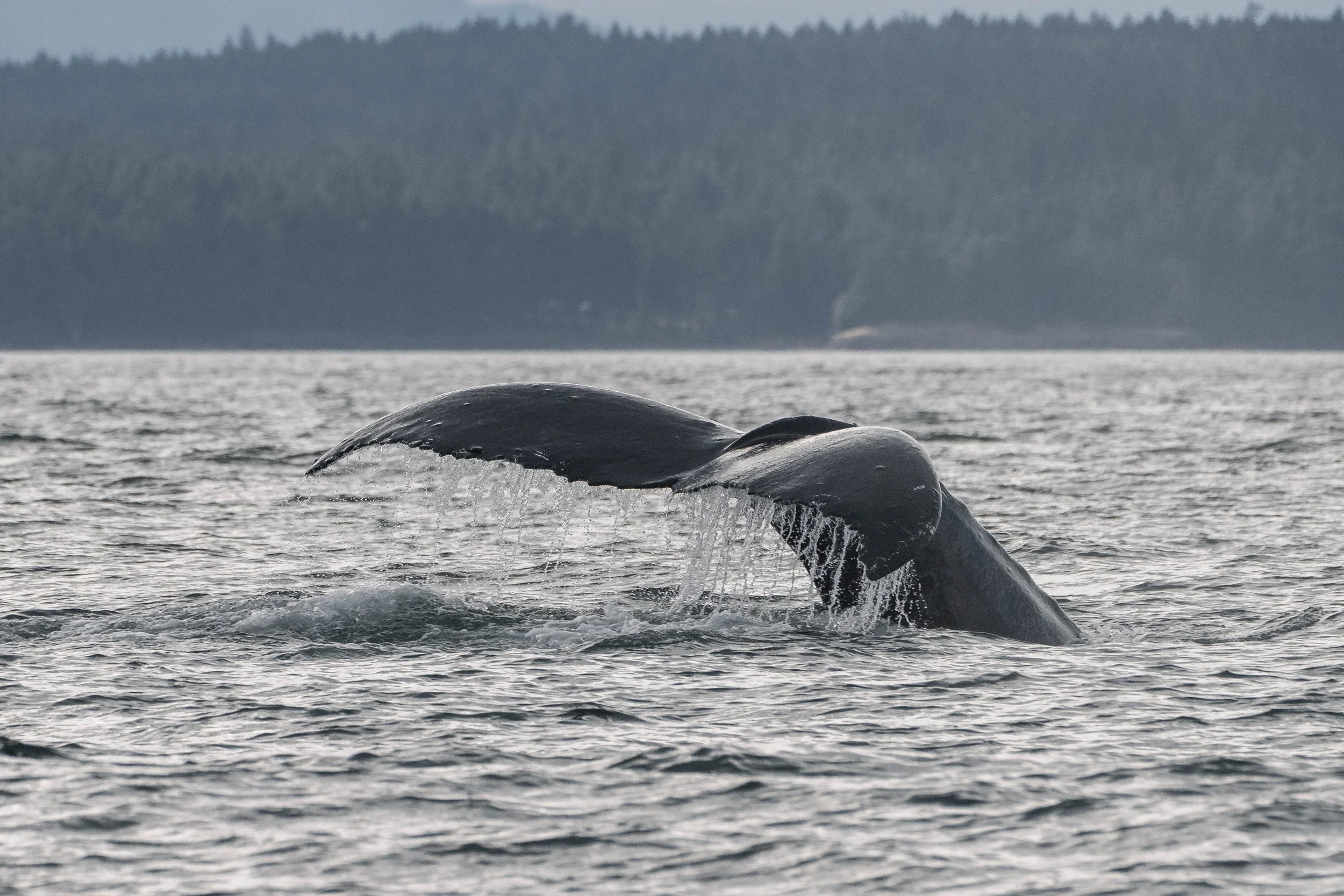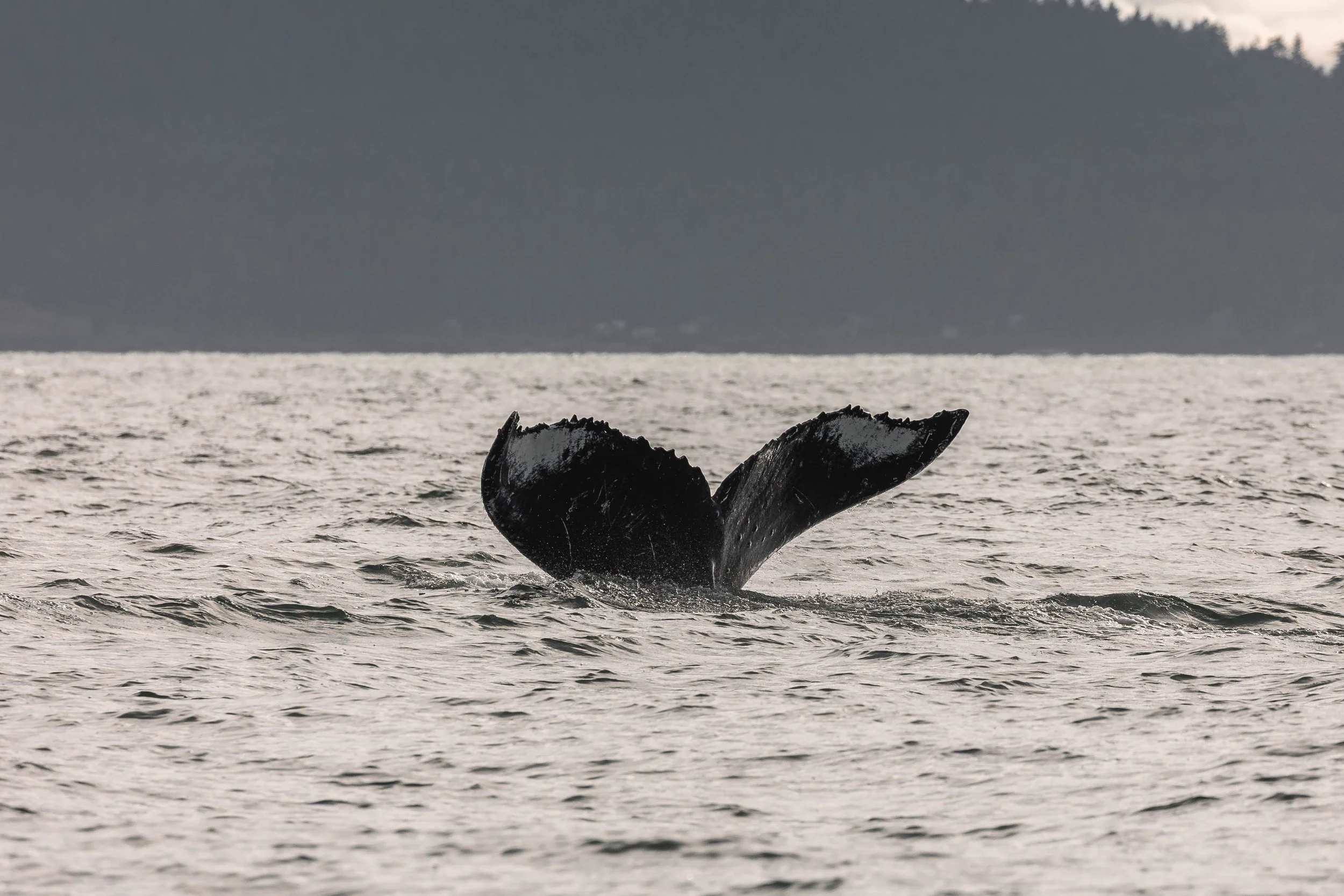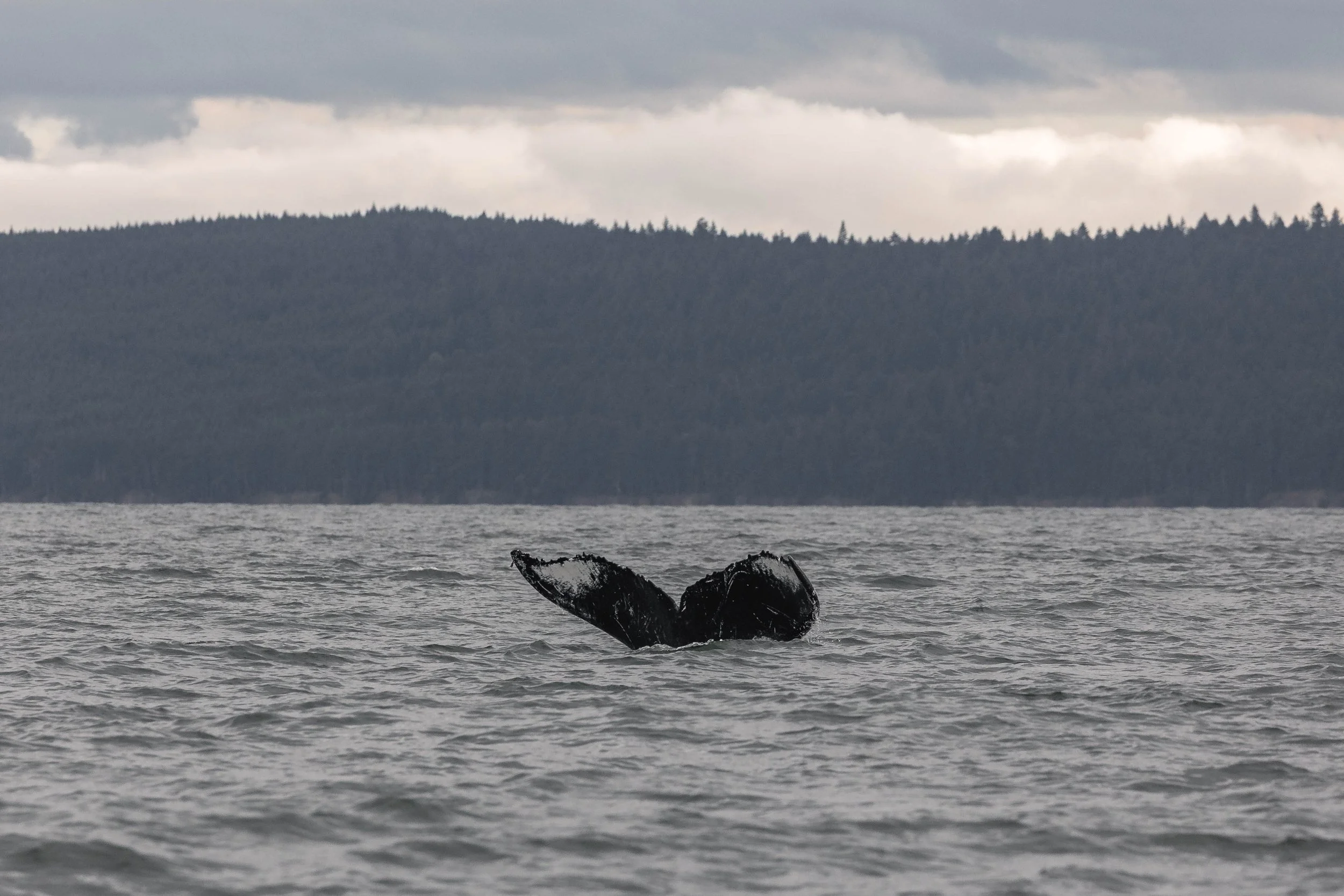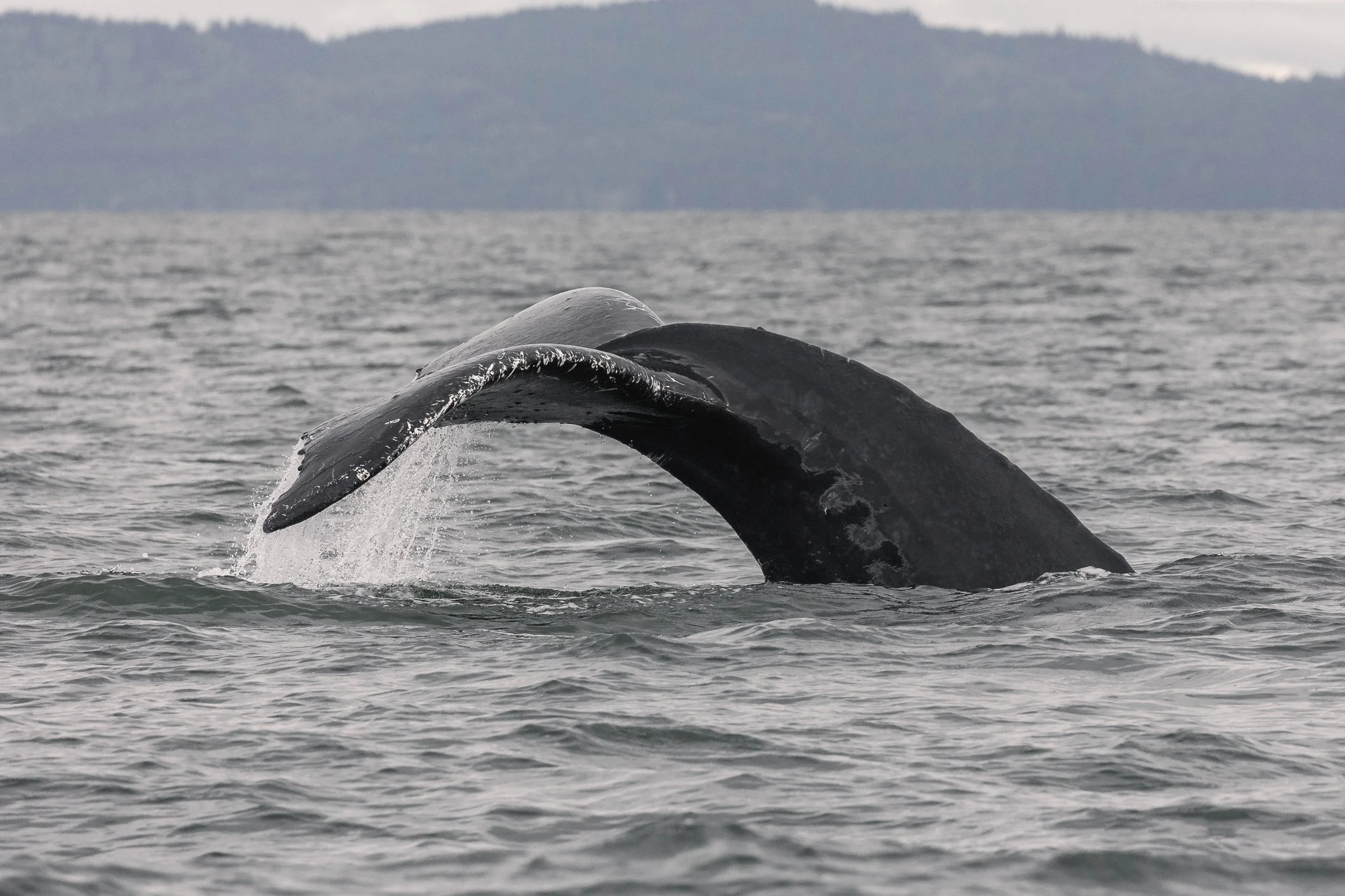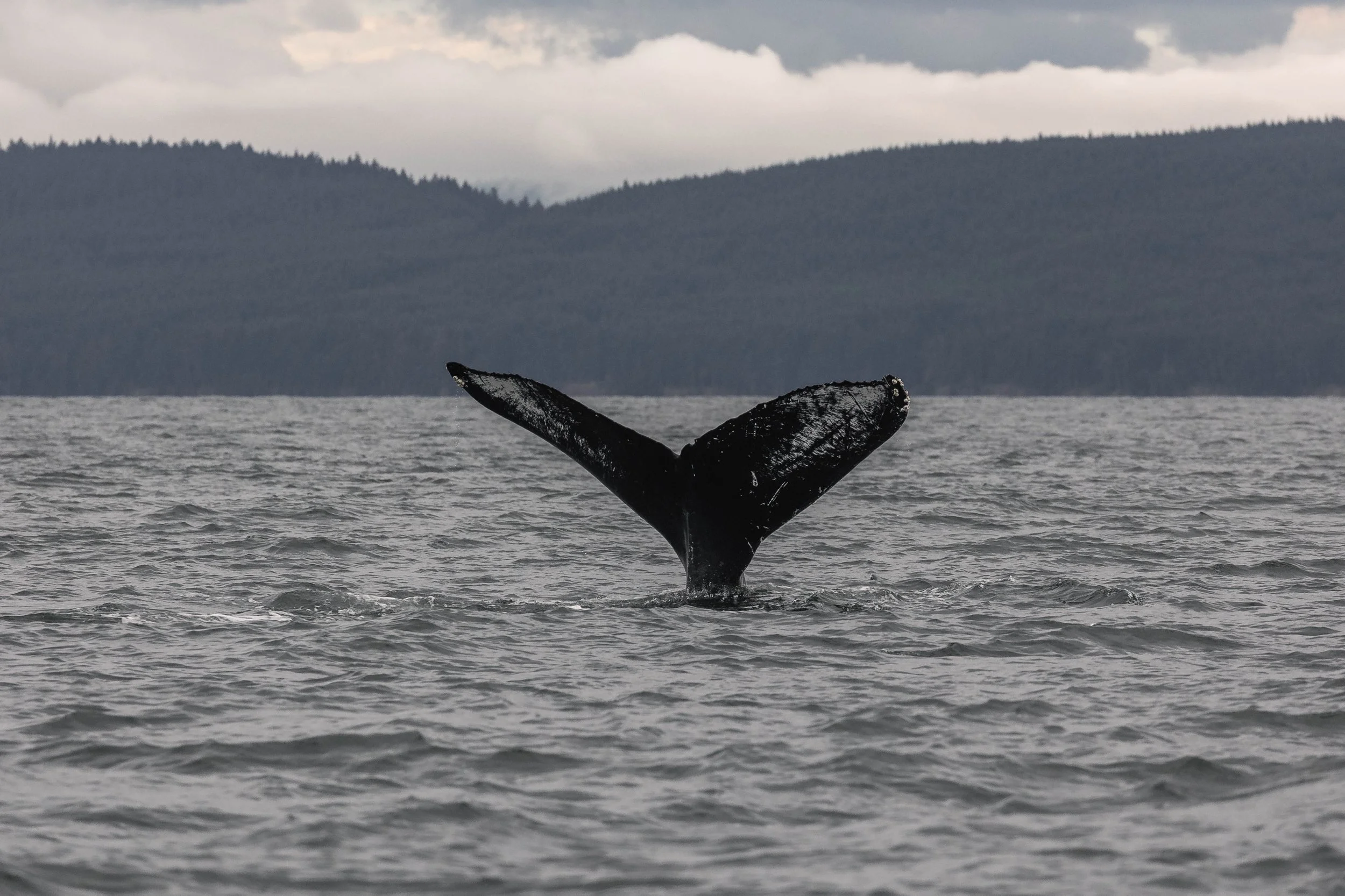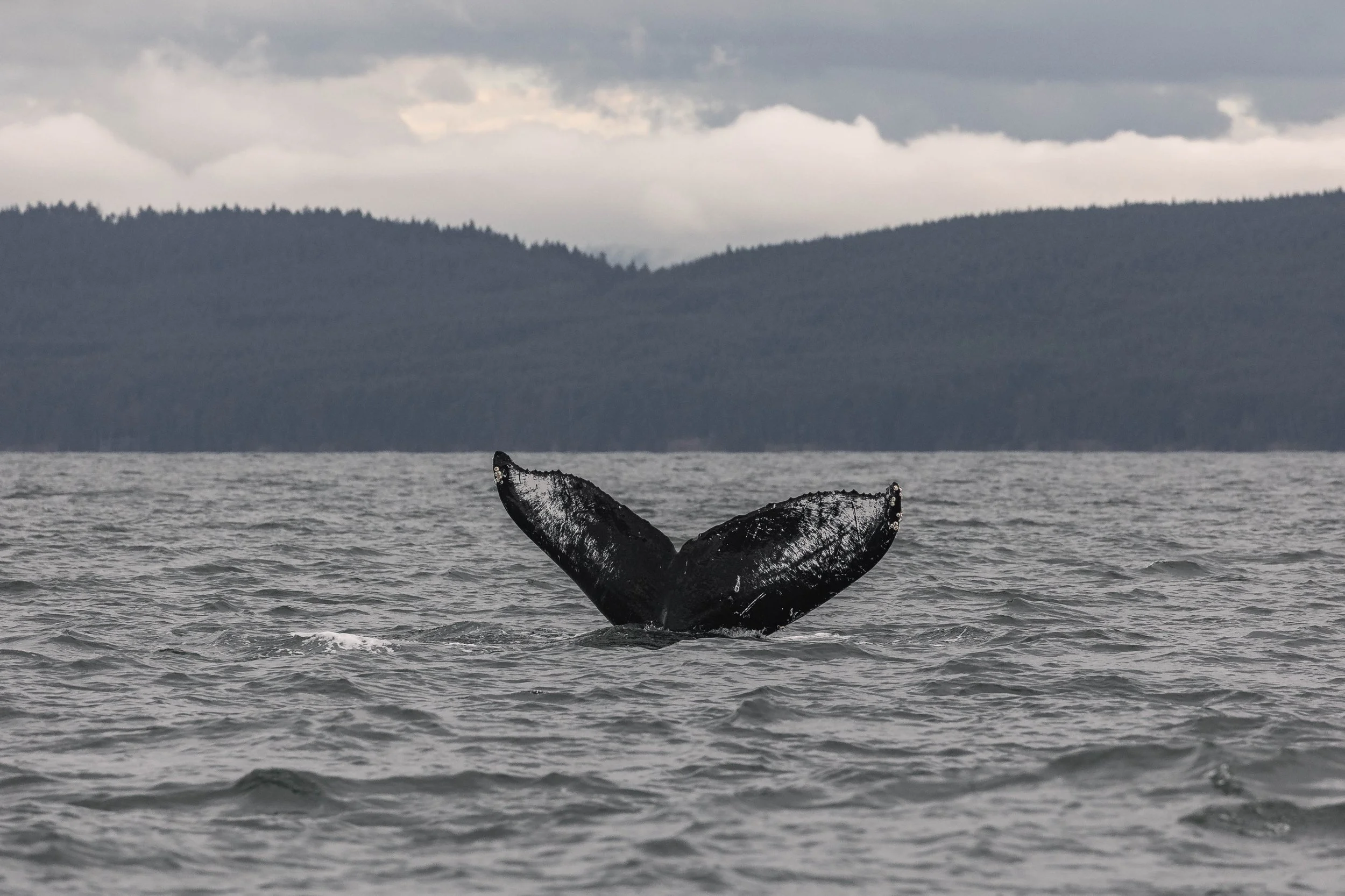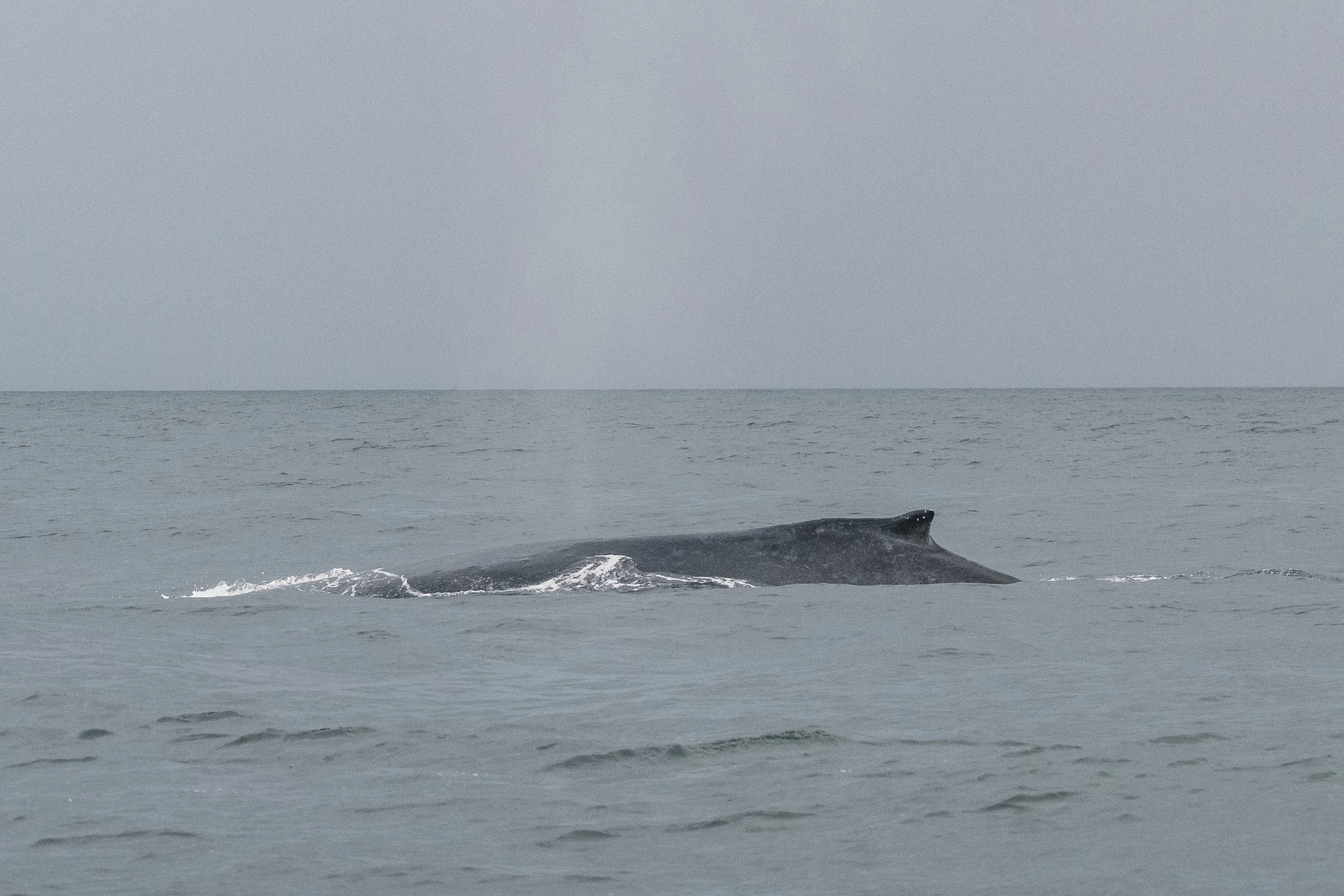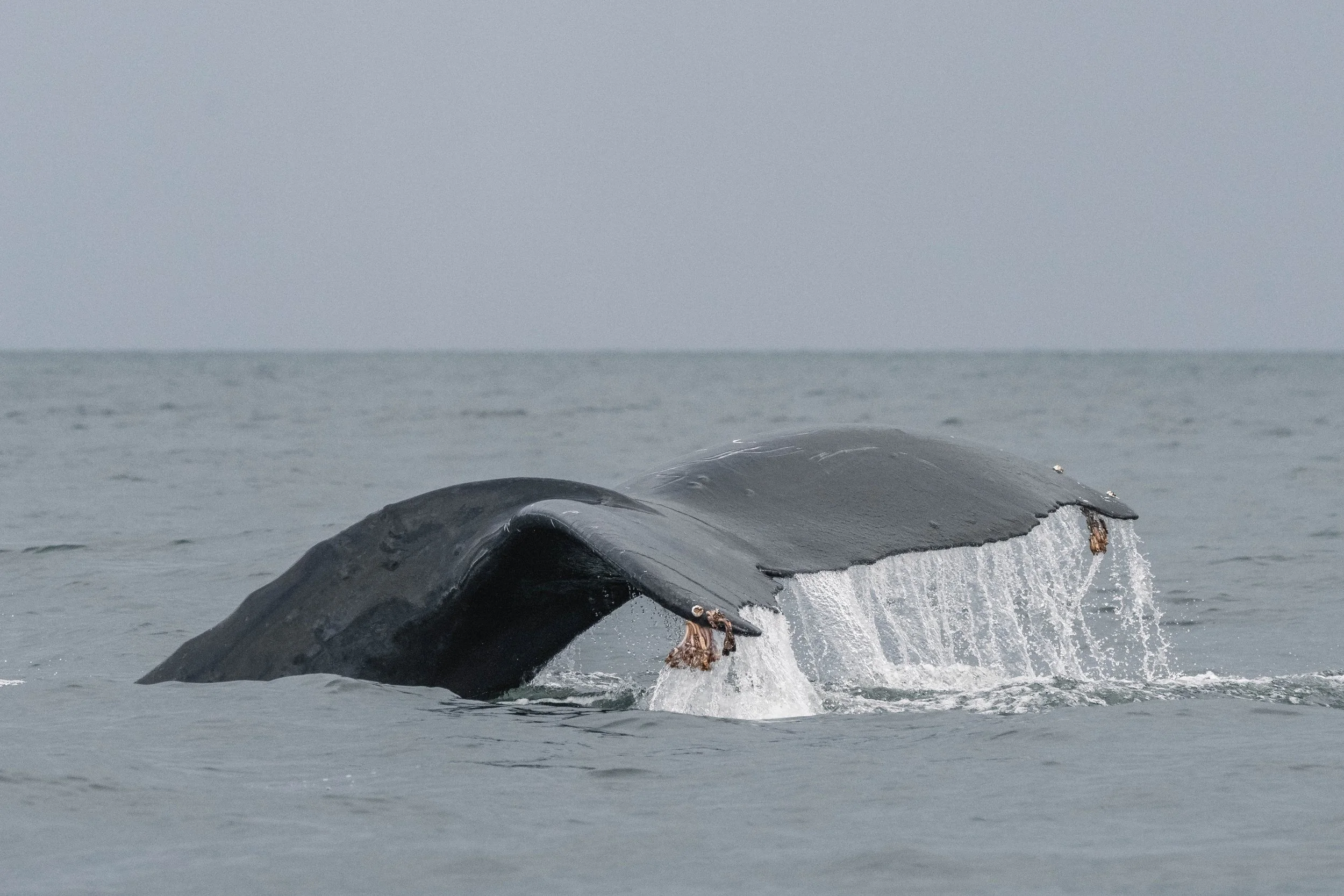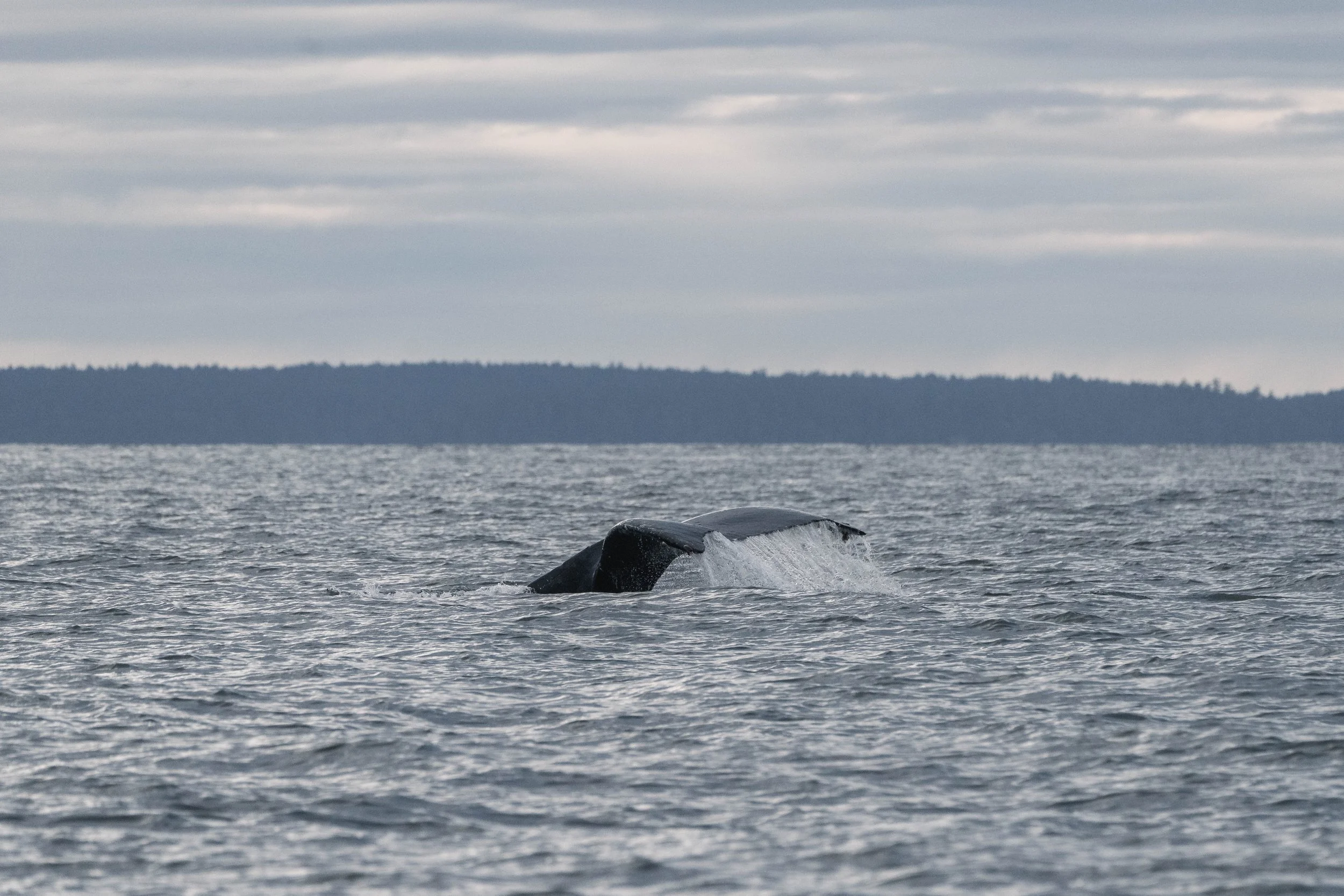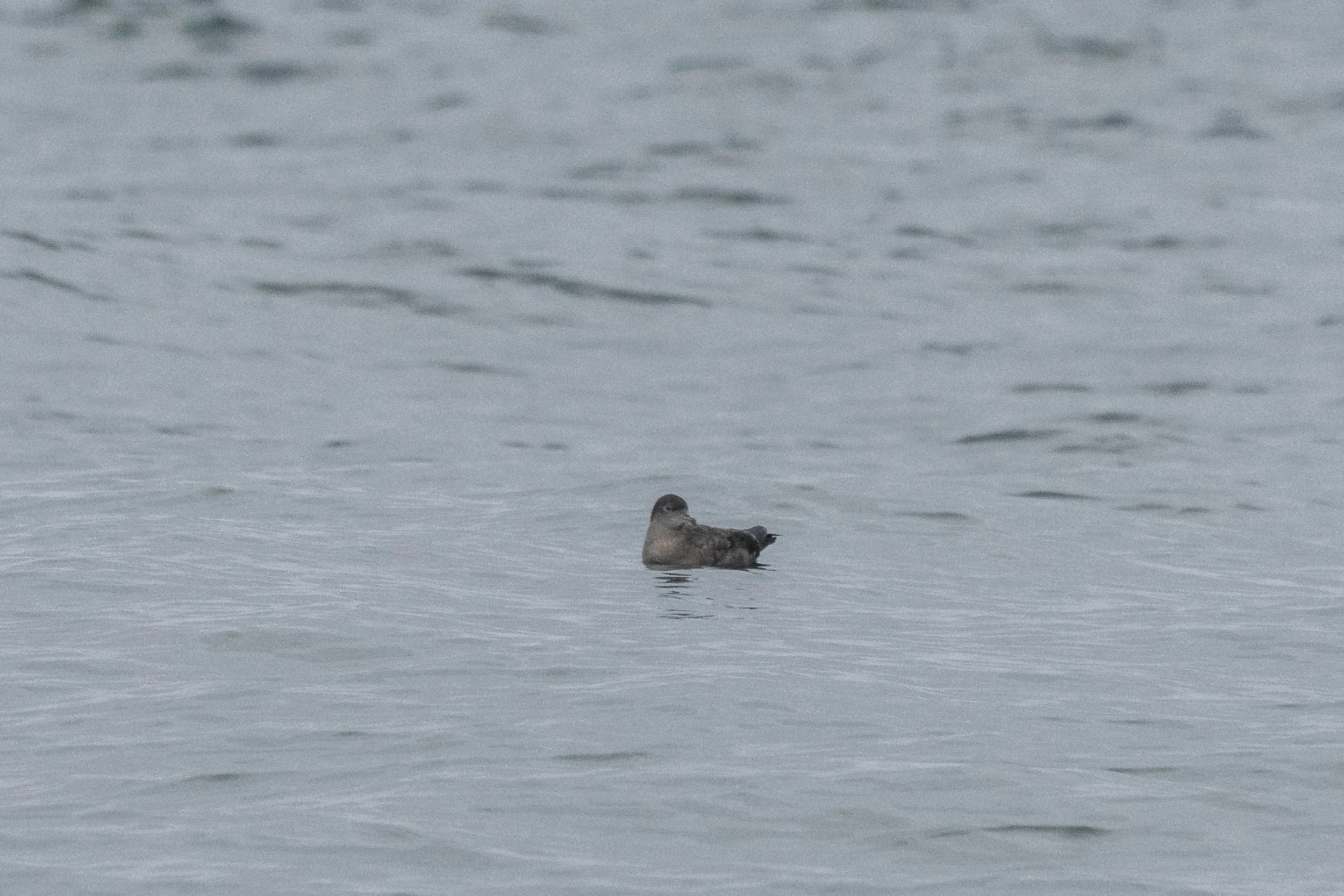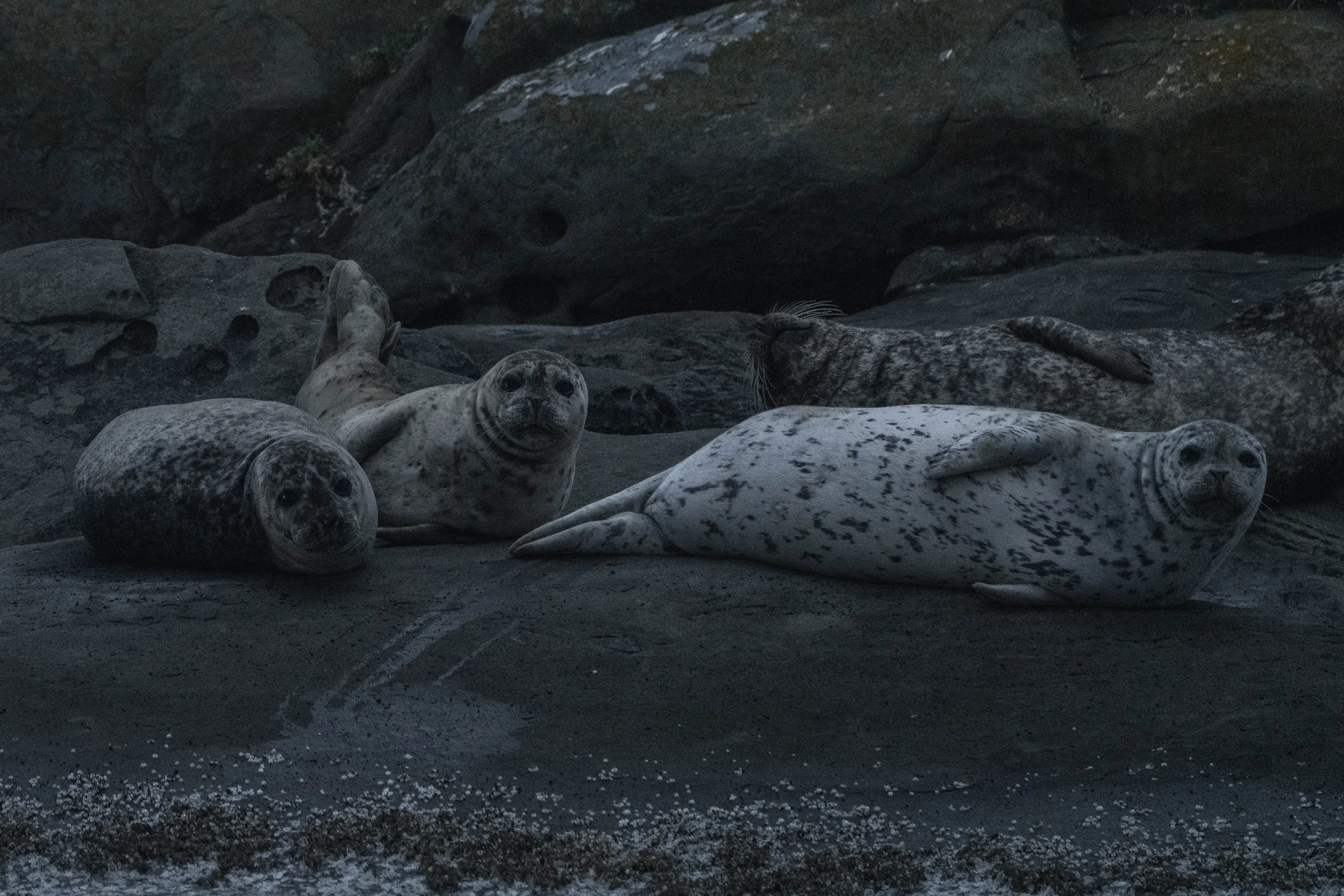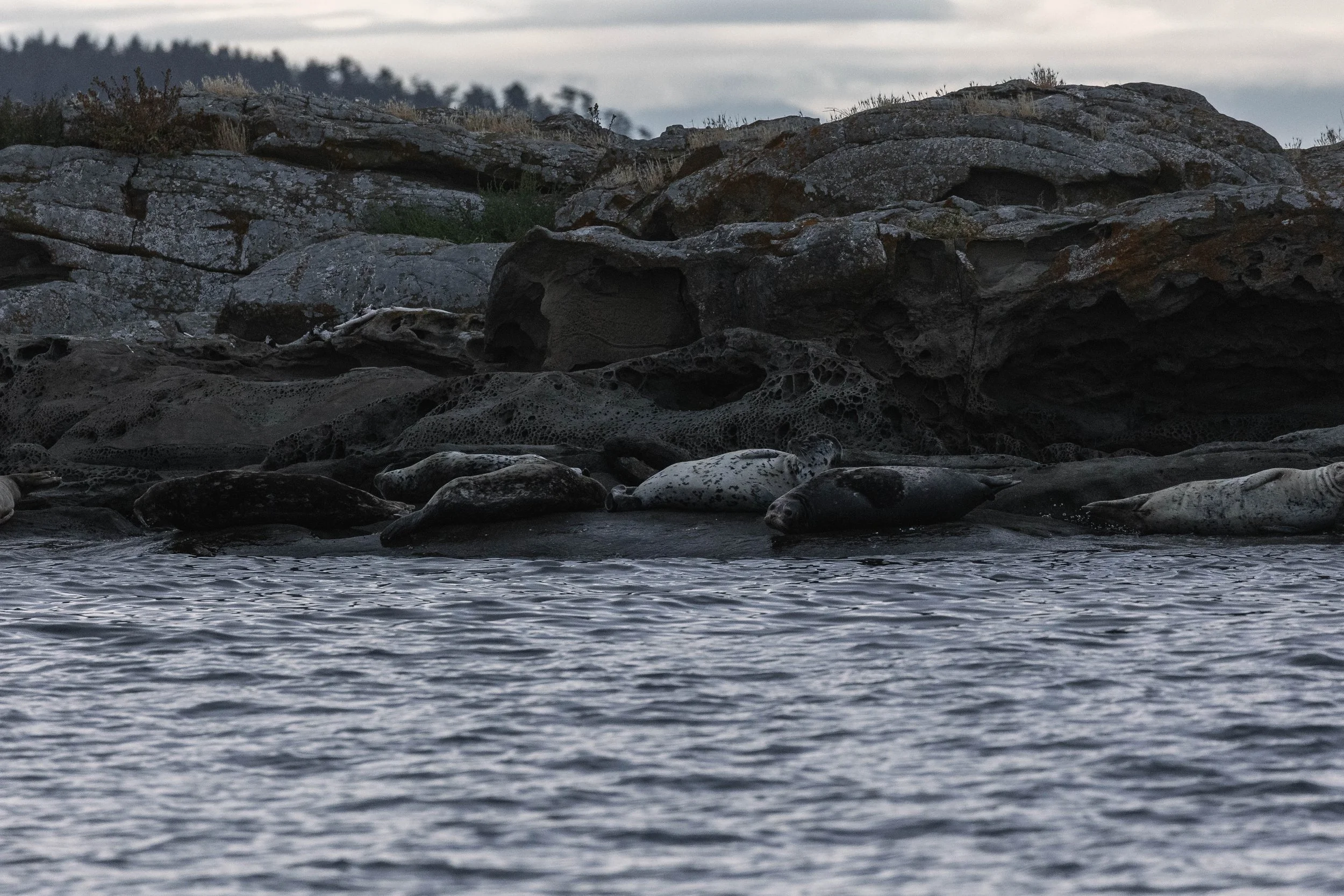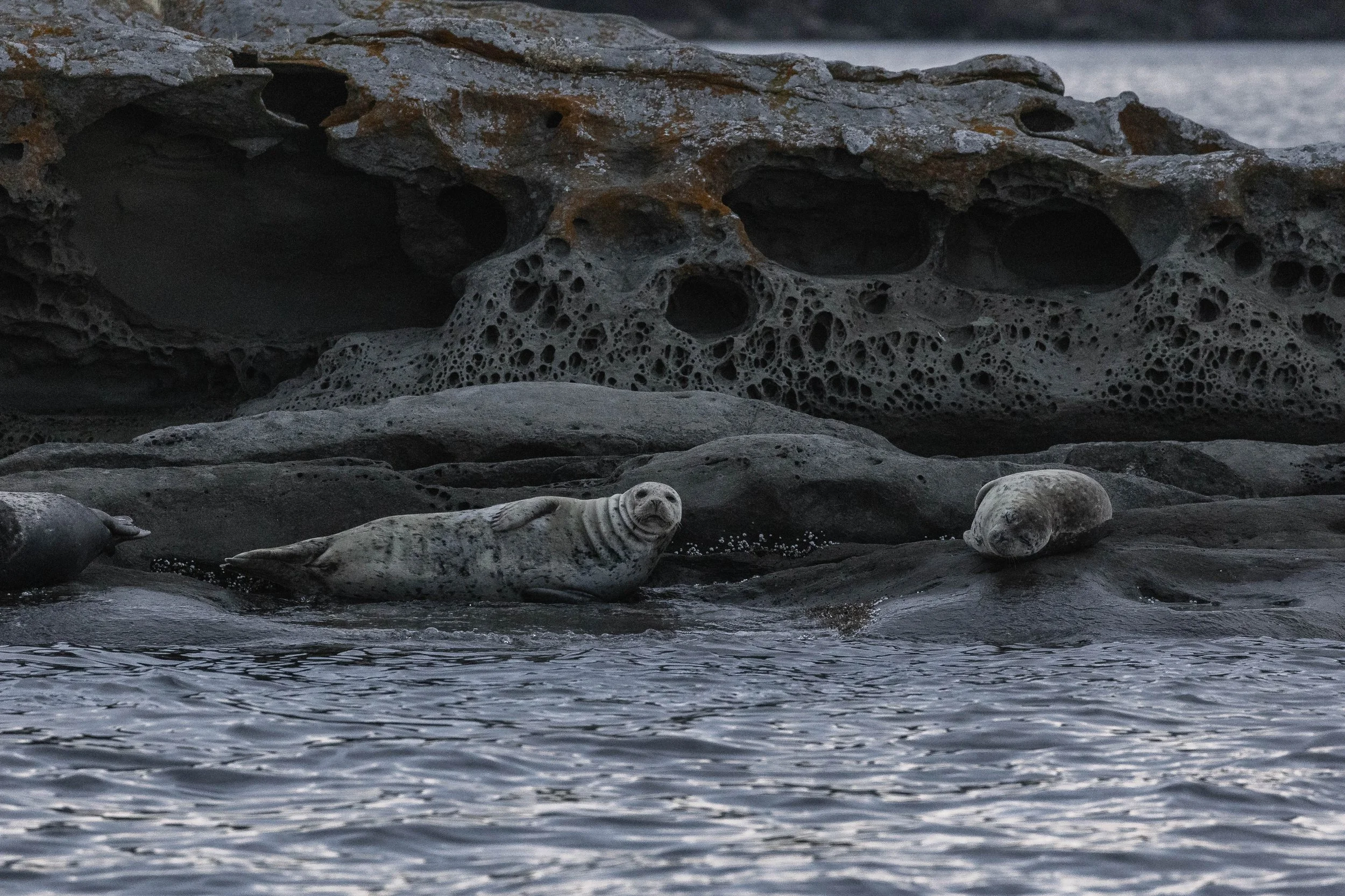September 14, 2025, 3:30 PM - Two Pairs of Humpbacks off Porlier Pass
For our final evening trip of the season, we began venturing south, exploring inside and around the Southern Gulf Islands. When each trip departs, we start fresh, never truly knowing where the day’s adventure will take us. Venturing out into the Strait of Georgia, we scanned around, hoping to spot some whales. We travelled along Valdes Island, where we spotted our first whales of the day - a pair of humpbacks travelling along together, fin-to-fin!
These two humpbacks were travelling along, fluking as they went. Occasionally, they were spotted tail flicking and trumpeting as well. To identify our humpbacks, we compare their flukes to our ID catalogues, and thankfully, both of these two were fluking nice and high, leading to many opportunities to get some good ID shots. These two were identified as Orion (BCX1251) and Poptart (BCY1014), two regulars to our area of the Salish Sea. Thanks to HappyWhale, both of these whales have also been cross-referenced to the Hawaiian breeding grounds, meaning they may have interacted in both the feeding grounds and the breeding grounds before!
Poptart is a younger whale, being the 2016 calf of Big Momma (BCY0324). She brought back her first calf of her own in 2023, and that young calf has been spotted in our area a handful of times in the last two years. Poptart is an excellent example of the strong site fidelity this species exhibits, as she returns to her natal feeding and breeding grounds annually. Interestingly, in recent years this trend has been defied a handful of times, with specific individuals travelling to different breeding grounds than where they were initially catalogued. Many aspects of humpback social dynamics remain a mystery to us, with one of the main points being whether they form long-term friendships during their extended migrations along the coast. While humpback names are usually given to individuals based on markings on their flukes, Poptart was a bit of an exception. While she was travelling by her mother’s side, she would frequently be seen ‘popping’ out of the water energetically, similarly to how a Poptart pops out of a toaster!
Orion is a bit older, with his first sightings dating back to 2008. Orion was not seen as a calf and was already a bit larger by the time he was first seen, so we are unsure of his exact age. He does seem to be a bit of a fighter, though, as every spring when he returns to our area to feed, he bears new scratches and scrapes along the underside of his fluke. This is likely due to breeding attempts, where he may be attempting to win the attention of a female by taking on other males. Orion’s nickname originated from a three-dot marking he had on his left fluke, reminiscent of the Orion’s Belt constellation; however, due to his past few years of escapades, this marking is now camouflaged by new markings.
After spending some time with Poptart and Orion, we began to depart, heading out to search for more wildlife. It didn’t take us too long to find more whales, though, as another pair of humpbacks were seen just outside of Porlier Pass! These two were being a bit more fluke shy than our original pairing, but we confirmed their identities as Phi/Corona (BCX1416) and Yogi (BCY0409).
Phi/Corona is another known female humpback, having been seen with a calf in tow in 2020, 2022, and 2024. If she keeps this pattern up, she is likely currently pregnant, and we could see another little one by her side next season! Humpback gestation is 11-12 months, meaning they spend an entire year (and an incredible two migration trips) pregnant. During this time, she eats as much as she can in the feeding grounds, in preparation for giving birth in the breeding grounds the following winter and lactating for her new calf. Once born, humpback calves grow at an incredible rate of roughly 90-100 lbs a day through their mother's super nutrient-dense milk. Humpback mothers do not feed in the breeding grounds, so they rely entirely on their ability to stockpile their fat stores in the summer to sustain not just themselves, but also their new bouncy baby - an incredible feat when you consider they are feeding in our area for only a few months!
Yogi does not have a confirmed gender, but it is assumed that they are a male, as their first sighting was back in 2006. At 19 years old, Yogi should have already been spotted with a calf if they were a female. Humpbacks are a species that exhibits minimal sexual dimorphism, meaning that, physically, females and males look nearly identical. The only physical difference between males and females is a grapefruit-sized bump found on the underside of the peduncle known as the Hemispherical Lobe. Scientists are still unsure what this bump’s purpose is, but they have determined that it is only found on female humpbacks. Unfortunately, the location on the body makes it very difficult to see in most encounters, so many of our humpbacks are listed as Unknown Gender their entire lives.
Humpbacks were not the only wildlife we saw during our tour, though! We also witnessed our Harbour Seals, one of our most prolific pinnipeds, hauled out high up on the rocks. These sedentary individuals tend to spend many hours of the day snoozing away on shore, resting and enjoying any potential sunshine that may peek through the clouds. Once part of a large government cull, their population was knocked down to an astonishingly low number of approximately 10,000 individuals. Their population has now recovered, and they are now considered a healthy and growing population in our area, with an estimated population of roughly 100,000 individuals. Similarly, Steller Sea Lions, another pinniped species we saw during our trip today, were also targeted during the culls. While no longer considered Endangered, they are still considered a Species of Special Concern, primarily due to the potential threat to their small breeding areas from issues such as oil spills.
Our trip concluded with us venturing back across the waters, enjoying the beautiful scenery of the West Coast, and heading back into harbour after a wonderful day out on the water.
Please enjoy these photos taken by Marine Naturalists Val Watson and Desarae Poier below.
Orion surfacing with Poptart lifting her tail just behind him. Photo by Val Watson.
The underside of Orion’s tail as he dives. Photo by Val Watson.
Poptart preparing to dive. Photo by Val Watson.
The beautiful underside of Poptart’s tail. Photo by Val Watson.
Orion surfacing in the waves. Photo by Val Watson.
A fluke waterfall from Orion. Photo by Val Watson.
Orion diving in th sunset. Photo by Val Watson.
Orion lifting his tail to dive. Photo by Val Watson.
Orion’s dorsal fin as he surfaces. Photo by Desarae Poier.
The underside of Orion’s tail as he goes for a dive. Photo by Desarae Poier.
Orion going for a dive. Photo by Desarae Poier.
The underside of Orion’s tail. Photo by Desarae Poier.
Orion’s distinct dorsal fin. Photo by Desarae Poier.
Orion going for a dive. Photo by Desarae Poier.
Poptart lifting her tail to dive. Photo by Desarae Poier.
The underside of Poptart’s tail as she dives. Photo by Desarae Poier.
Corona/Phi surfacing. Photo by Val Watson.
Corona/Phi going for a dive. Photo by Val Watson.
The underside of Corona/Phi’s tail as she dives. Photo by Desarae Poier.
Yogi going for a dive. Photo by Desarae Poier.
Yogi going for a dive. Photo by Val Watson.
A Storm Petrel floating by. Photo by Val Watson.
An uncommon sighting for the Salish Sea! Photo by Val Watson.
Harbour Seals lounging on the rocks. Photo by Val Watson.
The Harbour Seal are quite curious and often watch us right back. Photo by Val Watson.
Happy Harbour Seals on the rocks. Photo by Desarae Poier.
You can see the interesting sandstone formations just behind the Harbour Seals.Photo by Desarae Poier.
Steller Sea Lions on the UM buoy. Photo by Desarae Poier.

